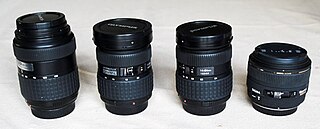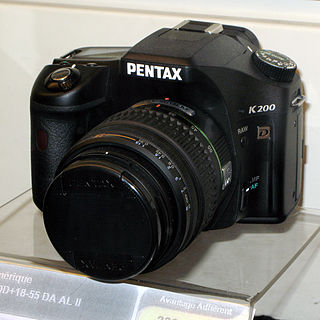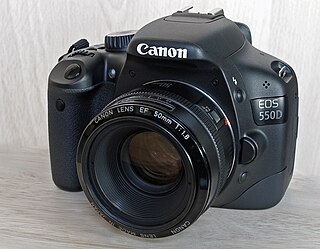
A digital single-lens reflex camera is a digital camera that combines the optics and the mechanisms of a single-lens reflex camera with a digital imaging sensor.

The NikonD50 is a 6.1-megapixel entry-level digital single-lens reflex camera, sold from June 2005 until November 2006 by Nikon. It was Nikon's first DSLR aimed at the consumer market, and sold for US$899. It uses the Nikon F mount. The D50 is similar to the slightly older D70 using the same CCD sensor, with a slower maximum shutter speed and slightly smaller size; however, it continued to offer the internal focus motor of prior autofocus film and digital SLRs. Future entry-level Nikon DSLRs would eliminate the internal focus motor and require these motors to be in the lenses. Lack of a focus-motor in the camera eliminated the ability to autofocus with late film-era Nikkor AF and AF-D lenses, though these lenses work well on the D50.

Advanced Photo System type-C (APS-C) is an image sensor format approximately equivalent in size to the Advanced Photo System film negative in its C ("Classic") format, of 25.1×16.7 mm, an aspect ratio of 3:2 and Ø 31.15 mm field diameter. It is therefore also equivalent in size to the Super 35 motion picture film format, which has the dimensions of 24.89 mm × 18.66 mm and Ø 31.11 mm field diameter.
A kit lens is a "starter" lens which can be sold with an interchangeable-lens camera such as a single-lens reflex camera. It is generally an inexpensive lens priced at the lowest end of the manufacturer's range so as to not add much to a camera kit's price. The kit consists of the camera body, the lens, and various accessories usually necessary to get started in SLR photography. A kit lens can be sold by itself outside of a kit, particularly the ones that are moderately expensive; for instance a kit lens included in a prosumer SLR kit is often marketed as an upgrade lens for a consumer SLR. In addition, retailers often have promotions of standalone low-end SLR bodies without the lens, or a package that bundles the SLR body with one or two more expensive lenses.

A full-frame DSLR is a digital single-lens reflex camera (DSLR) with a 35 mm image sensor format. Historically, 35 mm was one of the standard film formats, alongside larger ones, such as medium format and large format. The full-frame DSLR is in contrast to full-frame mirrorless interchangeable-lens cameras, and DSLR and mirrorless cameras with smaller sensors, much smaller than a full 35 mm frame. Many digital cameras, both compact and SLR models, use a smaller-than-35 mm frame as it is easier and cheaper to manufacture imaging sensors at a smaller size. Historically, the earliest digital SLR models, such as the Nikon NASA F4 or Kodak DCS 100, also used a smaller sensor.

The Pentax K10D and similar Samsung GX-10 are 10.2-megapixel digital single-lens reflex cameras launched in late 2006. They were developed in a collaboration between Pentax of Japan and Samsung of South Korea.

The Nikon D40 is Nikon F-mount entry-level digital SLR, announced November 16, 2006 and made until March 2009, when it was succeeded by the Nikon D3000. Compared to its predecessor, the D50, the D40 had several features removed, a few added, and a lower price: US$499.95 ESP as of November 2009 with the 18–55 mm G-II kit lens, positioning it as an entry-level model compared to the D80. The D40x has a 10-megapixel maximum resolution, up from 6 megapixels of the D40 and D50.

This article is about photographic lenses for single-lens reflex film cameras (SLRs) and digital single-lens reflex cameras (DSLRs). Emphasis is on modern lenses for 35 mm film SLRs and for DSLRs with sensor sizes less than or equal to 35 mm ("full-frame").

The Pentax K200D is a 10.2-megapixel digital single-lens reflex camera, announced on January 24, 2008, along with the higher-end K20D. It was discontinued in December 2008, giving it the distinction of being one of the shortest-lived DSLR cameras.
This article discusses the cameras – mainly 35 mm SLRs – manufactured by Pentax Ricoh Imaging Corp. and its predecessors, Pentax Corporation and Asahi Optical Co., Ltd.. Pentax must not be confused with Pentax 6x7 or Pentax 67 which are 120 medium format 6x7cm film cameras.

Pentax lenses were first badged as Takumar. The Takumar branded lenses were well respected for their line of Super Takumar, which designated the high performance coating applied to the lens as well as the optical formulas used to make them. The majority of the industry at the time was still satisfied with the variations of the "plumb" coating process and later some of the two and three layer processes as well. Asahi Pentax soon introduced the Takumar Super-Multi-Coated line of lenses which was a 7 layer process as the industry had just caught up with similar forms of 5 layer multi-coated optics. Eventually Asahi Optical and Pentax slowly shifted much of their lens production under the Pentax name and transitioned some of the successful designs that were first introduced under the Takumar name to use Asahi/Pentax badging as well as beginning to use the "smc" abbreviation. Eventually the Asahi partnership disappeared and the Pentax name became solely used. Pentax lenses saw many feature changes to answer the market, such as: incorporating "Auto-Aperture" with the M42, the light weight and compactness with the 'M' series, Aperture Priority overrides with the 'A' series, and Auto-Focus with the 'F' series. Modern Pentax lenses for digital SLR cameras have seen the elimination of the aperture ring completely as found on Pentax DA and D-FA series lenses. They use the Pentax KAF mount. All of these lenses have an autofocus feature, either operated from the camera body or from an internal SDM motor. Pentax compatible lenses are also made by third-party companies.

The Canon EOS 500D is a 15-megapixel entry-level digital single-lens reflex camera, announced by Canon on 25 March 2009. It was released in May 2009. It is known as the EOS Kiss X3 in Japan, and as the EOS Rebel T1i in North America. It continues the Rebel line of mid-range DSLR cameras, is placed by Canon as the next model up from the EOS 450D, and has been superseded by the EOS 550D (T2i).

The Pentax K-x is a 12.4 megapixel digital single-lens reflex camera, announced on September 16, 2009. The Pentax K-x uses a Sony Exmor sensor. In some cases it even approaches the quality produced by full-frame DSLRs like the Nikon D700 and the Canon 5DMkII, both with larger sensors. The Pentax K-x is suitable for low light conditions for both still and video photography.

The Canon EOS 550D is an 18.0 megapixel digital single-lens reflex camera, announced by Canon on 8 February 2010. It was available since 24 February 2010 and to US dealers from early March. It is known as the EOS Kiss X4 in Japan, and as the EOS Rebel T2i in the Americas. It is part of Canon's entry/mid-level digital SLR camera series, and was the successor model to the EOS 500D. It was succeeded by the EOS 600D, but remained in Canon's lineup until being discontinued in June 2012 with the announcement of the EOS 650D.

A mirrorless camera is a photo camera featuring a single, removable lens and a digital display. The camera does not have a reflex mirror or optical viewfinder like a digital single-lens reflex (DSLR) camera, but may have an electronic viewfinder. Many mirrorless cameras retain a mechanical shutter. Like a DSLR, a mirrorless camera accepts any of a series of interchangeable lenses compatible with its lens mount.

The Canon EOS 100D, known as the EOS Rebel SL1 in the Americas and EOS Kiss X7 in Japan, is an 18.0-megapixel digital single-lens reflex camera announced by Canon on 21 March 2013. It has been described as the "world's smallest and lightest DSLR camera", either currently in production or in the APS-C format. Canon uses a smaller version of the APS-C sensor format than some other manufacturers including Nikon, Pentax, and Sony, with a crop factor of 1.6 rather than 1.5. It weighs 407 grams including battery and memory card.

The Pentax K-3 is a 24-megapixel Pentax high-end digital single-lens reflex camera with an APS-C sensor, announced on 7 October 2013. The Pentax K-3 is the successor to both the K-5 II and K-5 IIs models, which have a 16-megapixel sensor. The K-5 II had an optical low pass filter or anti-aliasing (AA) filter that can prevent the appearance of moire patterning on the captured image. This filter reduces the sharpness of the image, so Pentax also produced the K-5 IIs which omitted this filter. In the K-3, Pentax obviated the need for providing two separate models by including a selectable AA filter "simulator". This mechanism vibrates the sensor when switched on, slightly blurring the image in a way that replaces the function of the optical AA filter, providing the same benefit as the filter in the K-5 II and other cameras with an optical AA filter. When the AA simulator is disabled, the sensor records a sharper image, as in the K-5 IIs.

The Nikon D5300 is an F-mount DSLR with a carbon-fiber-reinforced polymer body and other new technologies, announced by Nikon on October 17, 2013. It is a mid-range camera with a crop sensor and requires a minimum camera 8.3 raw plugin for Photoshop to process its .NEF files.

Nikon D3300 is a 24.2-megapixel DX format DSLR Nikon F-mount camera officially launched by Nikon on 7 January 2014. It was marketed as an entry-level DSLR camera for beginners and experienced DSLR hobbyist who were ready for more advanced specs and performance. It replaced the D3200 as Nikon's entry level DSLR. The D3300 usually came with an 18-55mm VR II kit lens, which is the upgraded model of older VR lens. The new kit lens has the ability to retract its barrel, shortening it for easy storage.

The Pentax K-S2 is a weather-sealed digital SLR camera announced by Ricoh on February 9, 2015. It is the first Pentax SLR to feature an articulated LCD, and it is the smallest DSLR to include this feature and also be weather-sealed. In 2015, the K-S2 won the TIPA Award in the category Best Digital SLR Advanced.


















